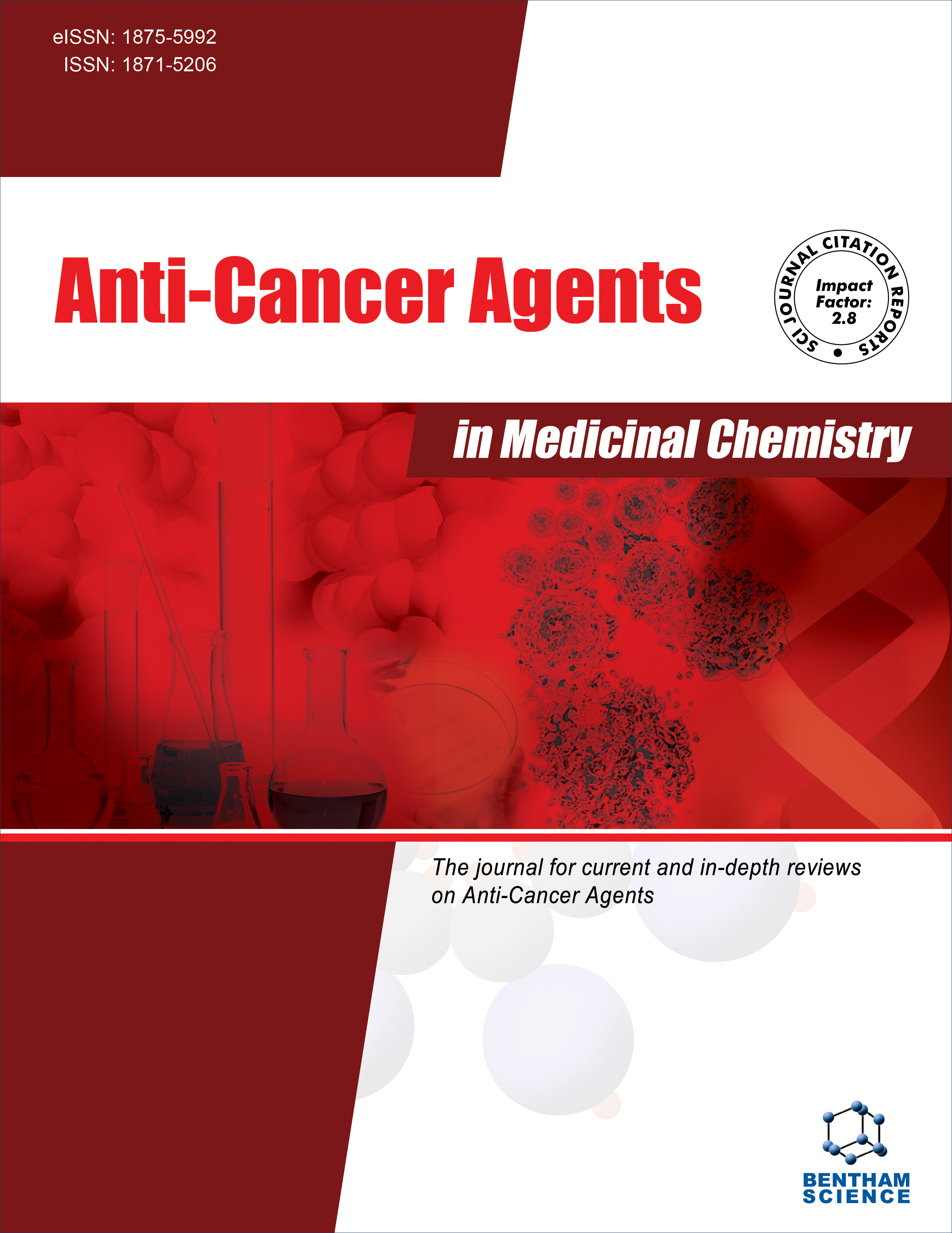- Home
- A-Z Publications
- Anti-Cancer Agents in Medicinal Chemistry (Formerly Current Medicinal Chemistry - Anti-Cancer Agents)
- Previous Issues
- Volume 9, Issue 2, 2009
Anti-Cancer Agents in Medicinal Chemistry (Formerly Current Medicinal Chemistry - Anti-Cancer Agents) - Volume 9, Issue 2, 2009
Volume 9, Issue 2, 2009
-
-
Marine Macrolides, a Promising Source of Antitumor Compounds
More LessAuthors: Jose G. Napolitano, Antonio H. Daranas, Manuel Norte and Jose J. FernandezMarine organisms have attracted scientific community as a rich source of natural products with unusual structural features and remarkable biological activities. Marine macrolides are a prominent class of natural products characterized by a highly oxygenated polyene backbone containing a macrocyclic lactone as a conformational constraint. Many marine macrolides possess outstanding cell growth antiproliferati Read More
-
-
-
Quercetin and Its Derivatives: Synthesis, Pharmacological Uses with Special Emphasis on Anti-Tumor Properties and Prodrug with Enhanced Bio-Availability
More LessAuthors: Ketan V. Hirpara, Pawan Aggarwal, Amrita J. Mukherjee, Narendra Joshi and Anand C. BurmanCancer is one of the leading causes of death in the world. American Cancer Society reported 12 million new cases of malignancy diagnosed worldwide in 2007, with 7.6 million people dying from the disease. Plant-derived molecules have played an important role in cancer chemotherapy. Many cytotoxic plant-derived molecules such as vinblastine, vincristine, navelbine, etoposide, teniposide, taxol, taxotere, topotecan and i Read More
-
-
-
Importance and Limitations of Chemotherapy Among the Available Treatments for Gastrointestinal Tumours
More LessAuthors: Jose J.G. Marin, Marta R. Romero, Alba G. Blazquez, Elisa Herraez, Emma Keck and Oscar BrizGastrointestinal tumours constitute one of the worldwide leading causes of death. One important limitation in the battle against these types of cancer is their lack of sensitivity to currently available chemotherapy and the development of drug resistance during treatment. The mechanisms responsible for this refractivity include a reduction in drug uptake, enhanced drug export, intracellular inactivation of the effective agent Read More
-
-
-
Copper Complexes as Anticancer Agents
More LessAuthors: Cristina Marzano, Maura Pellei, Francesco Tisato and Carlo SantiniMetal-based antitumor drugs play a relevant role in antiblastic chemotherapy. Cisplatin is regarded as one of the most effective drugs, even if severe toxicities and drug resistance phenomena limit its clinical use. Therefore, in recent years there has been a rapid expansion in research and development of novel metal-based anticancer drugs to improve clinical effectiveness, to reduce general toxicity and to broaden the spe Read More
-
-
-
Role of Tyrosine Phosphatase Inhibitors in Cancer Treatment with Emphasis on SH2 Domain-Containing Tyrosine Phosphatases (SHPs)
More LessAuthors: Mahban Irandoust, Timo K. van den Berg, Gertjan J.L. Kaspers and Jacqueline CloosProtein tyrosine phosphorylation is one of the key mechanisms involved in signal transduction pathways. This modification is regulated by concerted action of protein tyrosine phosphatases and protein tyrosine kinases. Deregulation of either of these key regulators lead to abnormal cellular signaling, which is largely associated with human pathologies including cancer. Although the role of protein tyrosine kinases in cancer is Read More
-
-
-
From Concept to Reality: The Long Road to c-Met and RON Receptor Tyrosine Kinase Inhibitors for the Treatment of Cancer
More LessAuthors: Isabelle Dussault and Steven F. Bellonc-Met and RON are receptor tyrosine kinases (RTK) that are closely related, both from a homology as well as from a functional stand point. Both receptors can induce cell migration, invasion, proliferation and survival in response to their respective ligand. Moreover, both possess oncogenic activity in vitro, in animal models in vivo and are often deregulated in human cancers. c-Met attracted a lot of interest shortly after its di Read More
-
-
-
Molecular Modeling Applied to Anti-Cancer Drug Development
More LessIn the past, anti-cancer drugs were identified and developed without focusing on a particular macromolecular target. Currently, the fields of molecular biochemistry, molecular biology, genetics and pharmacology, among other disciplines, have grown considerably in their ability to identify biological targets. These disciplines are now searching for specific targets to treat cancer. These targets exist in different cellular compa Read More
-
-
-
2-Deoxy-D-Ribose, a Downstream Mediator of Thymidine Phosphorylase, Regulates Tumor Angiogenesis and Progression
More LessAuthors: Yuichi Nakajima, Radha Madhyastha and Masugi MaruyamaAngiogenesis plays an important role in tumor metastasis and progression, and thus inhibiting angiogenesis is a promising strategy for treatment of cancer. However, tumor-associated angiogenesis is influenced by various angiogenic factors in the tumor microenvironment. Thymidine phosphorylase (TP, EC 2. 4. 2. 4), an enzyme involved in the reversible conversion of thymidine to thymine, is an important mediator of Read More
-
Volumes & issues
-
Volume 25 (2025)
-
Volume 24 (2024)
-
Volume 23 (2023)
-
Volume 22 (2022)
-
Volume 21 (2021)
-
Volume 20 (2020)
-
Volume 19 (2019)
-
Volume 18 (2018)
-
Volume 17 (2017)
-
Volume 16 (2016)
-
Volume 15 (2015)
-
Volume 14 (2014)
-
Volume 13 (2013)
-
Volume 12 (2012)
-
Volume 11 (2011)
-
Volume 10 (2010)
-
Volume 9 (2009)
-
Volume 8 (2008)
-
Volume 7 (2007)
-
Volume 6 (2006)
Most Read This Month
Article
content/journals/acamc
Journal
10
5
false
en


